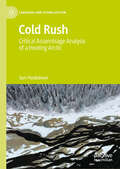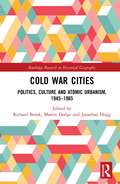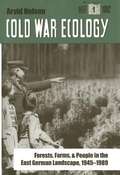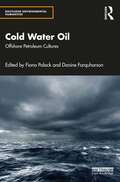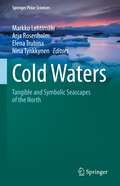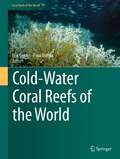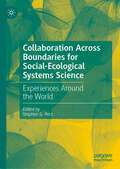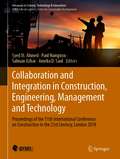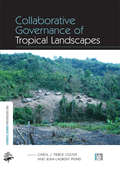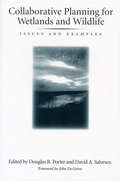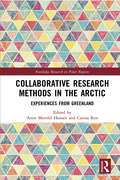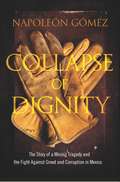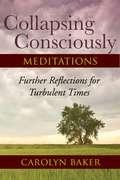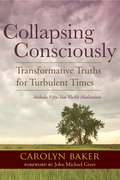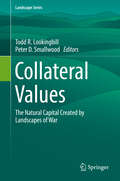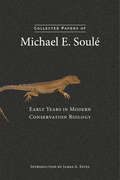- Table View
- List View
Cold Region Hazards and Risks
by Colin A. WhitemanThis is a unique, timely and engaging text with wide ranging geographical coverage. The text brings together, for the first time, information about a vast array of hazards associated with ice and snow, spanning both well known phenomenon (e.g. avalanches) and the less familiar (e.g. river ice jams and ice storms) using, in many cases, material which is rarely seen outside advanced academic research books and journals. The range of ice-related hazards will be introduced and the significance of the current global warming context discussed. Broad physical models of glacial, periglacial and atmospheric cold environments are presented to provide a scientific context for discussion of the human issues of risk, vulnerability impact and mitigation.Key Features:Wide ranging geographical coverage (the Americas, Asia, Australasia, Antarctic & Europe) Localised hazards (avalanches, life storms, landslides) contrasted to those with wider reaching effects (arctic ice loss, ice sheet retreat and wide spread permafrost decay) Includes the latest developments in the field Each chapter includes hazards overview, summery, conclusions, potential projects exercise and key references Includes a supplementary website with figures from the text and further references Each chapter includes a hazards overview, summary, conclusions, potential projects exercise and key references
Cold Rush: Critical Assemblage Analysis of a Heating Arctic (Language and Globalization)
by Sari PietikäinenThis book is an original study of Cold Rush, an accelerated race for the extraction and protection of Arctic natural resources. The Northernmost reach of the planet is caught up in the double developments of two unfinished forces – rapidly progressing climate change and global economic investment - working simultaneously in tension and synergy. Neither process is linear or complete, but both are contradictory and open-ended. This book traces the multiplicity of Cold Rush in the Finnish Arctic, a high-stakes ecological, economic, and political hotspot. It is a heterogeneous space, understood as indigenous land within local indigenous Sámi people politics, the last frontier from a colonial perspective, and a periphery under the modernist nation-state regime. It is now transforming into an economic hub under global capitalism, intensifying climate change and unforeseen geo-political changes. Based on six years of ethnography, the book shows how people struggle, strategize, and profit from this ongoing, complex, and multidirectional change. The author offers a new theoretical approach called critical assemblage analysis, which provides an alternative way of exploring the dynamics between language and society by examining the interaction between material, discursive, and affective dimensions of Cold Rush. The approach builds on previous work at the intersection of critical discourse analysis, critical sociolinguistics, nexus analysis and ethnography, but expands toward works by philosophers Michel Foucault, Gilles Deleuze, and Felix Guattari. This book will be of interest to researchers on language, discourse, and sociolinguistics interested in engaging with social critique embedded in global capitalism and accelerating climate change; as well as researchers in the social and human sciences and natural sciences, who are increasingly aware of the fact that the theoretical and analytical move beyond the traditional dichotomies like language/society, nature/human and micro/macro is central to understanding today´s complex, intertwined social, political, economic and ecological processes.
Cold War Cities: Politics, Culture and Atomic Urbanism, 1945–1965 (Routledge Research in Historical Geography)
by Martin Dodge Richard Brook Jonathan HoggThis book examines the impact of the Cold War in a global context and focuses on city-scale reactions to the atomic warfare. It explores urbanism as a weapon to combat the dangers of the communist intrusion into the American territories and promote living standards for the urban poor in the US cities. The Cold War saw the birth of ‘atomic urbanisation’, central to which were planning, politics and cultural practices of the newly emerged cities. This book examines cities in the Arctic, Europe, Asia and Australasia in detail to reveal how military, political, resistance and cultural practices impacted on the spaces of everyday life. It probes questions of city planning and development, such as: How did the threat of nuclear war affect planning at a range of geographic scales? What were the patterns of the built environment, architectural forms and material aesthetics of atomic urbanism in difference places? And, how did the ‘Bomb’ manifest itself in civic governance, popular media, arts and academia? Understanding the age of atomic urbanism can help meet the contemporary challenges that cities are facing. The book delivers a new dimension to the existing debates of the ideologically opposed superpowers and their allies, their hemispherical geopolitical struggles, and helps to understand decades of growth post-Second World War by foregrounding the Cold War.
Cold War Ecology: Forests, Farms, and People in the East German Landscape, 1945-1989
by Arvid NelsonEast Germany, its economy, and its society were in decline long before the country's political collapse in the late 1980s. The clues were there in the natural landscape, Arvid Nelson argues in this groundbreaking book, but policy analysts were blind to them. Had they noted the record of the leadership's values and goals manifest in the landscape, they wouldn't have hailed East Germany as a Marxist-Leninist success story. Nelson sets East German history within the context of the landscape history of two centuries to underscore how forest and ecosystem change offered a reliable barometer to the health and stability of the political system that governed them. Cold War Ecology records how East German leaders' indifference to human rights and their disregard for the landscape affected the rural economy, forests, and population. This lesson from history suggests new ways of thinking about the health of ecosystems and landscapes, Nelson shows, and he proposes assessing the stability of modern political systems based on the environment's system qualities rather than on political leaders' goals and beliefs.
Cold Water Oil: Offshore Petroleum Cultures (Routledge Environmental Humanities)
by Fiona PolackCold Water Oil: Offshore Petroleum Cultures is a collection of essays examining how societies conceive of fossil fuel extraction in the inhospitable but fragile waters of the North Atlantic and Arctic oceans. What happens offshore matters. Currently, over a quarter of the world’s oil and gas is produced from beneath the seas. The offshore petroleum industry is thus a crucial point of origin for global carbon emissions, and other environmental harms. Cold Water Oil: Offshore Petroleum Cultures illuminates ignored histories, influential contemporary narratives, and emerging energy and environmental futures. The volume centres on North Atlantic and Arctic regions; the continuing but often strongly contested pursuit of oil and gas in frigid, tumultuous, and environmentally sensitive seas enforces the lengths to which corporations and governments will go to maintain the centrality of fossil fuels. The book’s contributors focus on the cultural, social, and ecological implications of oil and gas extraction in the oceanic territories of Canada, Norway, the UK, Russia, the US, and the Iñupiat of Alaska at a time of profound global uncertainty. In conversation with the energy and environmental humanities, and critical ocean studies, Cold Water Oil considers a region central to debates about climate change and the planet’s future. Cold Water Oil engages students and researchers interested in climate change, energy humanities, critical ocean studies, and North Atlantic and Arctic issues.
Cold Waters: Tangible and Symbolic Seascapes of the North (Springer Polar Sciences)
by Arja Rosenholm Elena Trubina Markku Lehtimäki Nina TynkkynenThis book addresses the Arctic and the northern regions by exploring cold waters and northern seascapes. It focuses on cultural discourses and artistic representations concerning the human experience and imagination of how the Arctic Ocean has been explored and used. It aims to assess what is specific to the northern waters vis-à-vis other sea and water areas in the world. The contextual background is provided by the fundamental shift from terra-based thinking towards aqua-based thinking, including the histories of the northern waters and the innovative ocean studies of the last decades. This book will be of interest to readers in Arctic studies and Sea and Ocean studies (including those with interests in literature, history, cultural and film studies, anthropology and politics), Environmental History and Cultural studies as well as in Russian studies. The book has been assembled with a view towards upper-level undergraduate and post-graduate students and scholars and will also be appropriate for courses in the fields mentioned above. The book will be of interest to specialists working in and with Arctic environmental issues. There is a broad array of international academic networks, environmental, governance and cultural associations outside academia whose members may also find the book of interest.
Cold-Water Coral Reefs of the World (Coral Reefs of the World #19)
by Erik Cordes Furu MienisCold-water corals form reef structures in continental margin and seamount settings world-wide, making them more wide-spread and abundant than shallow-water reefs. Their role in these ecosystems is no less important than the influence that shallow-water coral reefs have on tropical systems. They create habitat structure, host endemic species, enhance elemental cycling, alter current flow, sequester carbon, and provide many other ecosystem services that we are just beginning to understand. The rapidly evolving state of knowledge of cold-water and deep-sea coral reefs has not been compiled in over 10 years. This volume synthesizes recent and historical information, reveals new findings from reefs that have been discovered only recently, and presents key avenues for future research. We are on the cusp of understanding the critical role that cold-water coral reefs play in the world’s oceans, and this book lays the foundation on which this knowledge will be built in the future.
Collaborating for Climate Equity: Researcher–Practitioner Partnerships in the Americas (Routledge Focus on Environment and Sustainability)
by Vivek Shandas Dana HellmanThis book explores the capacity of different stakeholders to work together and build urban resilience to climate change through an equity-centered approach to cross-sectoral collaboration. Urban areas, where the majority of the global population dwells, are particularly vulnerable to a myriad of climate stressors, the effects of which are acutely present in places and to communities that have been largely excluded from decision-making processes. Our need for working and learning together is at a critical threshold, yet at present, the process for and understanding of inter-sectoral collaborations remains a theoretical ideal and falls short of the broad appeal that many have claimed. Collaborating for Climate Equity argues that researcher–practitioner partnerships offer a promising pathway toward ensuring equitable outcomes while building climate resilience. By presenting five case studies from the United States, Chile, and Mexico, each chapter explores the contours of developing robust researcher–practitioner collaborations that endure and span institutional boundaries. The case studies included in the book are augmented by a synthesis that reflects upon the key findings and offers generalizable principles for applying similar approaches to other cities across the globe. This work contributes to a nascent knowledge base on the real-world challenges and opportunities associated with researcher–practitioner partnerships. It provides guidance to academics and practitioners involved in collaborative research, planning, and policymaking.
Collaborating for Museum Innovation: Technological, Cultural, and Organisational Innovation in Spanish Museums (Routledge Studies in Innovation, Organizations and Technology)
by Chuan LiThis book is a fresh reflection on the study of museum innovation, with special attention paid to the enabling role of collaboration within the process. It sets out to capture the innovation dynamics of museums and explore to what extent and how collaborative arrangement can contribute to different types of innovative activities in the museum sector. The book presents a holistic review of museum innovation from multiple perspectives of, among others, economics, sociology, museology, and organisational study, while adopting an interdisciplinary approach to explore and analyse the innovation process and collaboration mechanism from the viewpoint of economics and sociology. The research presented is based on three interdependent aspects: first, a holistic definition and taxonomy of innovation in museum organisations; second, qualitative and quantitative analysis of the enabling role of collaboration in technological, cultural, and organisational innovation in museums; and third, multiple case studies for the identification and evaluation of effective collaboration models in different types of innovation. This is a problem-oriented study, which avoids focusing on those large and super museums that have been well-documented in prior studies; instead, it concentrates on small- and medium-sized museums, which account for more than 85% of museums in the world and have become the main resources of cultural tourism and the creative economy at a regional level. Primarily written for postgraduates, researchers, and academics interested in innovation study, innovation in cultural and creative sectors, and museum study, the findings may also have important implications on innovation management and policy for regional museums and public authorities.
Collaboration Across Boundaries for Social-Ecological Systems Science: Experiences Around the World
by Stephen G. PerzCollaboration across boundaries is widely recognized as a vital requisite for the advancement of innovative science to address problems such as environmental degradation and global change. This book takes collaboration across boundaries seriously by focusing on the many challenges and practices involved in team science when spanning disciplinary, organizational, national and other divides. The authors draw on a shared framework for managing the challenges of collaboration across boundaries as applied to the science of understanding complex social-ecological systems.Teams working across boundaries on diverse social-ecological systems in countries around the world report their challenges and share their practices, outcomes and lessons learned. From these diverse experiences arise many commonalities and also some important differences. These provide the basis for a set of recommendations to any collaborators intending to use science as a tool to better understand social-ecological systems and to improve their management and governance.
Collaboration and Integration in Construction, Engineering, Management and Technology: Proceedings of the 11th International Conference on Construction in the 21st Century, London 2019 (Advances in Science, Technology & Innovation)
by Paul Hampton Syed M. Ahmed Salman Azhar Amelia D. SaulThis book gathers papers presented at the 11th International Conference on Construction in the 21st Century, held in London in 2019. Bringing together a diverse group of government agencies, academics, professionals, and students, the book addresses issues related to construction safety, innovative technologies, lean and sustainable construction, international construction, improving quality and productivity, and innovative materials in the construction industry. In addition, it highlights international collaborations between various disciplines in the areas of construction, engineering, management, and technology. The book demonstrates that, as the industry moves forward in an ever-complex global economy, multi-national collaboration is crucial, and its future growth will undoubtedly depend on international teamwork and alliances.
Collaboration for Sustainability and Innovation: A Cross-Border, Multi-Stakeholder Perspective (Greening of Industry Networks Studies #3)
by James J. Cordeiro Joseph Sarkis Diego A. Vazquez-BrustA number of arguments are made by an international group of authors in this though provoking book about an understudied and socially important context. A future in which financial wealth transfers across the North-South divide from richer to poorer countries is far from sufficient for the relief of poverty and the pursuit of sustainability. Caution must be taken when growth is achieved through the liquidation of the natural wealth of poorer nations, in order to maintain a global economic status quo. Neither poverty reduction nor sustainability will ultimately be achieved. The financial collapse and social upheaval that might result will make the most recent economic downturn look trivial by comparison. What is more urgently needed instead, as argued in this book, is collaboration for sustainability and innovation in the global South, especially building on models originally developed in the South that are transferable to the North. In pursuit of a sustainable and more equitable future, the book examines such topics as Cross-Border Innovation in South-North Fair Trade Supply Chains; Potential Pollution Prevention Programs in Bangladesh; Digital Literacy and Social Inclusion in the South through Collective Storytelling and Eco-innovation at the 'Bottom of the Pyramid'. Many of these stories and have not been told and need greater visibility. The book contributes in a meaningfully to the discussion of how innovation and sustainability science can benefit both sides in South-North innovation collaborations. It provides useful introduction to the topics, as well as valuable critiques and best practices. This back-and-forth flow of ideas and innovation is itself new and promising in the modern pursuit of a fair and sustainable future for all regions of our planet.
Collaborative Approach to Trade: Enhancing Connectivity in Sea- and Land-Locked Countries (Advances in Spatial Science)
by Alan Wilson Francesca Romana Medda Francesco Caravelli Simone CaschiliThis book applies regional analysis to the challenges facing global investment agencies seeking to enhance trade in lagging regions. It shows how spatial interaction and agent-based modelling can be used as the basis for developing new plans and policies. An in-depth analysis of trade routes is presented, which can be used to develop policies for increasing efficiency and reducing costs. Landlocked Uganda and the sea-locked South Pacific Islands serve to illustrate the problems of covering sizable distances, accelerating export flows and improving supply chain efficiency. These examples also provide an excellent illustration of the power of regional science, from assembling data bases in difficult situations to developing and applying models of the trade system.
Collaborative Environmental Governance Frameworks: A Practical Guide
by Timothy GiesekeThis book takes a practical approach to understanding and describing collaborative governance for resolving environmental problems. It introduces a new collaborative governance assessment model and recognizes that collaborations are a natural result of organizations converging around complex issues. Rather than identifying actors by their type of organization, the actors are identified by the type of role they play. This approach is aligned with how individuals and organizations interact in practice, and their dependance on collaborations to solve emerging environmental problems. The book discusses real cases with governance issues and creates new frameworks for collaborations. Features: Addresses communities at all levels and scales that are gravitating toward collaborations to solve their environmental issues. Prepares and enables individuals to participate in collaborative governance and design collaborative governance frameworks. Introduces the first simplified and standardized model to assess governance using governance actors and styles. Explains governance in simple terms and builds governance frameworks from the individual’s perspective; the smallest, viable unit of governance in a collaboration. Describes "tools of convergence" for collaborative leaders to organize and align activities to create shared-governance outcomes and outputs.
Collaborative Governance of Tropical Landscapes (The Earthscan Forest Library)
by Carol J. Pierce Colfer Jean-Laurent PfundThis book provides a novel approach to governance relating to biodiversity and human well-being in complex tropical landscapes, including forests and protected areas. It focuses attention at the interface between communities and the landscape level, building on interdisciplinary research conducted in five countries (Cameroon, Indonesia, Laos, Madagascar and Tanzania). In each country, the research was set within the framework of a major national policy thrust. The book improves our understanding of and ability to manage complex landscapes---mosaics of differing land uses---in a more adaptive and collaborative way that benefits both the environment and local communities. It includes both single country and cross-site analyses, and focuses on themes, such as resettlement, land use planning, non-timber forest product use and management, the disconnect between customary and formal legal systems, and the role of larger scale policies in local level realities. Chapters also analyze experience with monitoring and a local governance assessment tool. The work also provides guidance for those interested in management and governance at lower and intermediate levels (village, district), scales likely to grow in importance in the global effort to mitigate and adapt to climate change.
Collaborative Planning for Wetlands and Wildlife: Issues And Examples
by Douglas R. Porter Leah Haygood Mary Jean Matthews Mark B. Adams Ed Finder David SalvesenCollaborative Planning for Wetlands and Wildlife presents numerous case studies that demonstrate how different communities have creatively reconciled problems between developers and environmentalists. It answers questions asked by regulators, environmentalists, and developers who seek practical alternatives to the existing case-by-case permitting process, and offers valuable lessons from past and ongoing areawide planning efforts.
Collaborative Research Methods in the Arctic: Experiences from Greenland (Routledge Research in Polar Regions)
by Anne Merrild HansenThis book addresses the growing demand for collaborative and reflexive scholarly engagement in the Arctic directed at providing relevant insights to tackle local challenges of arctic communities. It examines how arctic research can come to matter in new ways by combining methods and engagement in the field of inquiry in new and meaningful ways. Research informs decisions affecting the futures of arctic communities. Due to its ability to include local concerns and practices, collaborative research could play a greater role in this process. By way of example of how to bring new voices to the fore in research, this edited collection presents experiences of researchers active in collaborative arctic research. It draws multidisciplinary perspectives from a broad range of academics in the fields such as law and medicine over tourism and business studies, planning and development, cultural studies, ethnology and anthropology. It also shares personal experiences of working in Greenland and with Greenlanders, whether communities, businesses and entrepreneurs, public officials and planners, patients or students. Offering useful insights into the current problems of Greenland representative of the arctic region, this book will be beneficial for researchers and scientists involved in arctic research.
Collaborative Social Design with Mexican Indigenous Communities: Critical Craft and Transformative Practices (Routledge Research in Social Design)
by Carmen MalvarThis book builds on the work of anthropologists, designers, and ethnographers to develop an original methodology and framework for indigenous engagement and designer/non-designer collaboration in the field of social design. Following a collaborative case study conducted over a five-year period between the author, project team, and indigenous artisans in Mexico, the book outlines the practical challenges of design research, including funding, logistics, relationships between designers and communities, failures, successes, and pivots. Social design literature has often focused on introducing important questions to the design research process, but fails to deeply interrogate and demonstrate how these theories inform research projects in action, which can then be open to misinterpretation, bias, and unintended harmful consequences. Centering the indigenous communities, this book provides a detailed and clear example of not just why, but how design and designers can work authentically and responsibly through different approaches and systems. The book examines the specific cultural, epistemological and socio-political history of Mexico as it relates to colonization and indigenous peoples, exploring the systemic influences of globalization and grounding the research in its unique context. It includes field notes, conversations with the indigenous artisan communities, workshops and prototypes to offer unique insight into a detailed, collaborative social design initiative. This book intersects with the growing awareness of the necessity of decolonial approaches to design across the world and will be an important and useful study for academics, students and researchers in social design, sustainable development, cultural studies and anthropology.
Collapse of Dignity: The Story of a Mining Tragedy and the Fight Against Greed and Corruption in Mexico
by Napoleon Gomez UrrutiaIn this book, Napoleon Gomez Urrutia tells the story of the Mexican government's war against the National Union of Mine, Metal, and Steelworkers of the Mexican Republic (Los Mineros) and of the union's eight-year battle of resistance.
Collapse of Metastability: Dynamics of First-Order Phase Transition (Fundamental Theories of Physics #211)
by Seiji MiyashitaTo understand phenomena in nature, it is important to focus not only on properties of stationary states, but also their changes in time, that is, the dynamics between bistable states. This book reviews the mechanics of first-order phase transitions and discusses relaxation and collapses of metastable states from various viewpoints, including Kramers' method for the lifetime of metastability, Langer’s analysis on the singularity, effects of thermal fluctuation studied by Néel and Brown, and eigenvalue structures of the transfer-matrix for the phase transitions. The book also goes into the mechanics of metastability in quantum systems from the viewpoints of the eigenvalue problem of the Hamiltonian and the Liouvillian for a dynamical process and discusses relations between quantum tunneling processes and metastability therein. Lastly, the coercivity of magnets consisting of an ensemble of grains is reviewed. The book is beneficial for those new in the field as a primer on first-order phase transition from modern perspectives. The comprehensive content offers overviews of related topics and allows readers to quickly catch up with developments in the field.
Collapsing Consciously Meditations: Further Reflections for Turbulent Times
by Carolyn BakerThis collection of more than 300 meditations weaves together spiritual wisdom, inspiration, humor, and a persistent challenge to create and savor beauty in the world, regardless of how bleak the future may appear. As a companion to the book Collapsing Consciously: Transformative Truths for Turbulent Times, these additional meditations are for readers seeking profound emotional and spiritual preparation for the impending collapse of industrial civilization. Author Carolyn Baker offers wisdom, inspiration, and a sense of spiritual purpose for anyone who is concerned about the daunting future humankind has created. Instead of quoting discouraging statistics about our predicament, Baker offers a deeper perspective that makes sense of a world that most of the time appears psychotic or even surreal. Through inspiration and perennial wisdom she has created a manual for making meaning and generating joy, especially in situations that feel hopelessly devoid of both. Also available: Collapsing Consciously: Transformative Truths for Turbulent Times, ISBN 978-1-58394-712-8.
Collapsing Consciously: Transformative Truths for Turbulent Times (Sacred Activism #3)
by John Michael Greer Carolyn BakerA collection of probing essays and weekly meditations, this book addresses how to prepare emotionally and spiritually for the impending collapse of industrial civilization. Author Carolyn Baker offers wisdom, inspiration, and a sense of spiritual purpose for anyone who is concerned about the daunting future humankind has created.The author's introduction to Collapsing Consciously articulates our current predicament of economic collapse, environmental degradation, and global conflict and expresses the confusion, anxiety, grief, anger, and despair we all experience when we take a hard look at the present-day global crisis and the likely future of the planet. But rather than showing us ways to prevent the collapse, Baker argues that the demise of our consumerist, corporate culture is inevitable, and that it is crucial to prepare emotionally and spiritually for the certain changes to come.Part 1 is a collection of seventeen essays which argue that while the collapse of industrial society cannot be prevented, its meaning extends far beyond tragedy and loss. These essays ask the reader to delve inward and discover the limitless treasures of the soul, as well as the gratification and exhilaration to be discovered in joining with community in preparing for the future.In part 2, Baker offers fifty-two weekly meditations comprised of spiritual wisdom, inspiration, paradox, comfort, humor, irony, and a persistent challenge to create and savor beauty in the world, regardless of how bleak the future may appear.Collapsing Consciously is a refreshing take on the perilous present and the grim prospects for our future. Instead of quoting discouraging statistics about our predicament, Baker offers a deeper perspective that makes sense of a world that most of the time appears psychotic or even surreal. Through inspiration and perennial wisdom she has created a manual for making meaning and generating joy, especially in situations that feel hopelessly devoid of both.An ebook containing additional meditations is also available: Collapsing Consciously Meditations: Further Reflections for Turbulent Times, ISBN 978-1-58394-758-6.From the Trade Paperback edition.
Collapsing Gracefully: Making a Built Environment that is Fit for the Future
by Robert Vale Brenda Vale Emilio GarciaThis innovative book investigates the concept of collapse in terms of our built environment, exploring the future transition of modern cities towards scenarios very different from the current promises of progress and development. This is not a book about the end of the world and hopeless apocalyptic scenarios. It is about understanding change in how and where we live. Collapse is inevitable, but in the built environment collapse could imply a manageable situation, an opportunity for change or a devastating reality. Collapsing gracefully means that there might be better ways to coexist with collapse if we learn more about it and commit to rebuild our civilisations in ways that avoid its worst effects. This book uses a wide range of practical examples to study critical changes in the built environment, to contextualise and visualise what collapse looks like, to see if it is possible to buffer its effects in places already collapsing and to propose ways to develop greater resilience.The book challenges all agents and institutions in modern cities, their designers and planners as well as their residents and users to think differently about built environment so as to ease our coexistence with collapse and not contribute to its causes. .
Collateral Values: The Natural Capital Created by Landscapes of War (Landscape Series #25)
by Todd R. Lookingbill Peter D. SmallwoodThis book explores the unanticipated benefits that may arise after wars and conflicts, showing how the preservation of battlefields and the establishment of borderlands can create natural capital in the former landscapes of war. The editors call this Collateral Value, in contrast to the collateral damage that war inflicts upon infrastructure, natural capital, and human capital. The book includes case studies recounting successes and failures, opportunities and risks, and ambitious proposals. The book is organized in two sections. The first visits U.S., English, and French battlefield sites dating from medieval England to World War I. The second explores borderlands located on several continents, established to end or prevent conflict. Both of these can create value beyond their original purpose, by preserving natural areas and restoring biodiversity. Among the topics covered are: · Registering English Battlefields · Old forts and new amenities in the Southern Plains of the U.S. · Verdun, France, and the conservation of WWI cultural and natural heritage · Conservation lessons learned in the Cordillera del Condor Corridor of the Andes mountains · Korea’s DMZ and its nature preserve · Wakhan National Park, a mountainous buffer area between Afghanistan and Pakistan The book examines state-of-the-art applications of landscape ecology, including methods for change detection, connectivity analysis, and the quantification of ecosystem services. Also included is a chapter on a creative proposal for “Guantánamo 2.0,” which would transform the Gitmo detention facility into a peace park and ecological research center. A concluding chapter appraises the past, present, and future of Collateral Values.Collateral Values: The Natural Capital Created by Landscapes of War benefits a broad audience of advanced undergraduate and graduate students, researchers, and practicing professionals.
Collected Papers of Michael E. Soulé: Early Years in Modern Conservation Biology
by Michael E. SouléIn the early 1970s, the environmental movement was underway. Overpopulation was recognized as a threat to human well-being, and scientists like Michael Soulé believed there was a connection between anthropogenic pressures on natural resources and the loss of the planet's biodiversity. Soulé--thinker, philosopher, teacher, mentor, and scientist--recognized the importance of a healthy natural world and with other leaders of the day pushed for a new interdisciplinary approach to preserving biological diversity. Thirty years later, Soulé is hailed by many as the single most important force in the development of the modern science of conservation biology. This book is a select collection of seminal writings by Michael Soulé over a thirty-year time-span from 1980 through the present day. Previously published in books and leading journals, these carefully selected pieces show the progression of his intellectual thinking on topics such as genetics, ecology, evolutionary biology, and extinctions, and how the history and substance of the field of conservation biology evolved over time. It opens with an in-depth introduction by marine conservation biologist James Estes, a long-time colleague of Soulé's, who explains why Soulé's special combination of science and leadership was the catalyst for bringing about the modern era of conservation biology. Estes offers a thoughtful commentary on the challenges that lie ahead for the young discipline in the face of climate change, increasing species extinctions, and impassioned debate within the conservation community itself over the best path forward. Intended for a new generation of students, this book offers a fresh presentation of goals of conservation biology, and inspiration and guidance for the global biodiversity crises facing us today. Readers will come away with an understanding of the science, passion, idealism, and sense of urgency that drove early founders of conservation biology like Michael Soulé.

